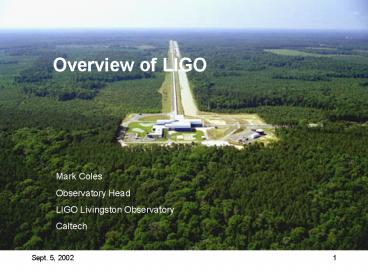Overview of LIGO - PowerPoint PPT Presentation
1 / 14
Title:
Overview of LIGO
Description:
LIGO consists of three laser interferometers located at two sites separated by 3000 km. ... New 'high water mark' for gravitational wave searches. ... – PowerPoint PPT presentation
Number of Views:98
Avg rating:3.0/5.0
Title: Overview of LIGO
1
Overview of LIGO
Mark Coles Observatory Head LIGO Livingston
Observatory Caltech
2
LIGO Laser Interferometer Gravitational-wave
Observatory
- LIGO consists of three laser interferometers
located at two sites separated by 3000 km. - The other two are at the same facility in eastern
Washington, on the Department of Energys Hanford
Nuclear Reservation, - Operated by Caltech in partnership with MIT
through a cooperative agreement with the National
Science Foundation.
3
The LIGO Science Collaboration scientific body
of LIGO which defines science goals, supports
their achievement.
LSC Membership 35 institutions gt 350
collaborators
International India, Russia, Germany, U.K,
Japan and Australia.
- University of Adelaide ACIGA
- Australian National University ACIGA
- California State Dominquez Hills
- Caltech LIGO
- Caltech Experimental Gravitation CEGG
- Caltech Theory CART
- University of Cardiff GEO
- Carleton College
- Cornell University
- University of Florida _at_ Gainesville
- Glasgow University GEO
- University of Hannover GEO
- Harvard-Smithsonian
- India-IUCAA
- IAP Nizhny Novgorod
- Iowa State University
- Joint Institute of Laboratory Astrophysics
- LIGO Livingston LIGOLA
- LIGO Hanford LIGOWA
- Louisiana State University
- Louisiana Tech University
- Loyola Univ of New Orleans
- MIT LIGO
- Max Planck (Garching) GEO
- Max Planck (Potsdam) GEO
- University of Michigan
- Moscow State University
- NAOJ - TAMA
- University of Oregon
- Pennsylvania State University Exp
- Pennsylvania State University Theory
- Southern University
- Stanford University
- University of Texas_at_Brownsville
- University of Western Australia ACIGA
- University of Wisconsin_at_Milwaukee
The international partners are involved in all
aspects of the LIGO research program.
GWIC Gravitational Wave International Committee
4
International network of gravitational wave
interferometers now being brought into operation
Virgo
GEO
LIGO
TAMA
Coincident detection to enhance detection
confidence source location decompose the
polarization of gravitational waves
AIGO
5
LSU Participation in LIGO is broad and well
integrated
- Faculty research and student participation
- Experimentally
- Active seismic isolation
- Wave front sensors
- Interferometer characterization
- Data analysis
- Theoretically
- Quantitative descriptions of astrophysical
sources of gravity waves - Infrastructure support
- Legal support for site acquisition and permits
- liaison with state (access road)
- Internet connection and support at LSU, and with
Bell South - Outreach activities
- 16 inch LTIF telescope (with LSU Physics Prof.
Greg Guzik) - We want to encourage additional joint activities
to strengthen our partnership.
6
Some History...
- Electromagnetic observation of the universe with
photons - Visible radiation
- atoms near surface of stars,
- surrounding gas clouds
- reflected radiation from planets and moons
- Other frequencies radio, x-ray, gamma ray
- Particle astrophysics
- cosmic rays
- neutrinos (solar neutrinos, SN1987 A)
- What about gravity as a messenger of
astrophysical information?
7
Einsteins Theory of Gravitation gravitational
waves
- a necessary consequence of Special Relativity
with its finite speed for information transfer - Einstein in 1916 and 1918 put forward the
formulation of gravitational waves in General
Relativity - time dependent gravitational fields come from
the acceleration of masses and propagate away
from their sources as a space-time warpage at the
speed of light
gravitational radiation binary inspiral of
compact objects
8
GWs from Hulse-Taylor binary
emission of gravitational waves by compact binary
system
- Only 7 kpc away
- period speeds up 14 sec from 1975-94
- orbital energy loss ?shortening of period
- deviation grows quadratically with time
- beautiful agreement (lt0.4 discrepancy) with GR
prediction of energy loss due to gravitational
radiation
9
Only positive mass exists, so dipole
displacements are not allowed by conservation of
momentum
quadrupole radiation is lowest order radiation
multipole
Gravitational source from quadrupole deformation
of a sphere
10
Gravitational Wave Antenna quadrupole strain
sensitivity
Displacement 10-19 meters for 4 km path!
Initial position of freely suspended test
mass Displaced test mass position
11
Status
- First 16 day Science Run now in progress.
- New high water mark for gravitational wave
searches. - 9th in a series of data runs to check and
characterize the detectors, software, procedures.
12
(No Transcript)
13
Plans
- Further commissioning of interferometer control
systems to achieve design sensitivity - Plan to collect at least one year of integrated
coincident data during 2003-2006 - Developing plans and proposals to install a major
upgrade at both sites following data collection - Development of technologies for improved
interferometers underway - Multiple pendulum suspensions
- Active seismic isolation
- High power lasers and optics
14
In an inertial reference frame Positive and
negative charge allows dipole radiation
Electromagnetic Radiation
Wave propagation direction
- - -

